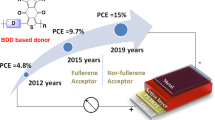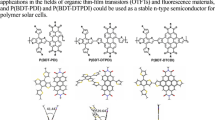Abstract
Three conjugated polymers based on thienyl-substituted benzodithiophene (BDT) and 4,7-bis-thienyl-benzothiadiazole (DTBT) with varied substitution positions of the alkyl side chains were synthesized to investigate the correlations between the structure and photovoltaic performance of the polymer photovoltaic materials. The three polymers named PBDTDTBT-p, PBDTDTBT-o and PBDTDTBT-m were characterized by a set of methods including absorption spectroscopy, cyclic voltammetry, thermogravimetric analysis, X-ray diffraction, density functional theory and photovoltaic measurements. The results show that the steric hindrance caused by the different substitution positions of the alky chains has a significant influence on the photovoltaic properties of the polymers. The open-circuit voltage (V oc) of the photovoltaic devices based on the three polymers could range from 0.67 to 0.90 V. Clearly, this finding provides us a feasible strategy to optimize the photovoltaic properties by simply changing the positions of the alkyl chains.
摘要
本文将具有不同取代位点的二维共轭支链引入到PBDTDTBT类聚合物的苯并二噻吩单元上, 设计和合成了三种骨架相同的两维共轭聚合物, 即PBDTDTBT-p, PBDTDTBT-o和PBDTDTBT-m, 并在此基础上探究了烷基链取代位点对共轭聚合物的光伏性质以及器件性能的影响. 通过吸收光谱、 循环伏安、 热失重分析、 X射线衍射、 光伏测试以及理论计算等手段对比研究了三种聚合物光伏材料, 结果表明由不同烷基链取代位点引起的分子空间位阻作用对三种聚合物的光物理性质、 微观形貌以及光伏性能有着重要的影响. 基于三种聚合物制备的光伏器件的开路电压可从0.67 V变化到0.90 V, 其光伏效率也相应地从3.48%提高到5%以上. 调节烷基链取代位点是一种简单有效制备高性能聚合物光伏材料的优化策略.
Similar content being viewed by others
References
Dou L, You J, Hong Z, et al. 25th anniversary article: a decade of organic/polymeric photovoltaic research. Adv Mater, 2013, 25: 6642–6671
Cheng YJ, Yang SH, Hsu CS. Synthesis of conjugated polymers for organic solar cell applications. Chem Rev 2009, 109: 5868–5923
Chen J, Cao Y. Development of novel conjugated donor polymers for high-efficiency bulk-heterojunction photovoltaic devices. Acc Chem Res, 2009, 42: 1709–1718
Beaujuge PM, Fréchet JMJ. Molecular design and ordering effects in π-functional materials for transistor and solar cell applications. J Am Chem Soc, 2011, 133: 20009–20029
Li YF. Molecular design of photovoltaic materials for polymer solar cells: toward suitable electronic energy levels and broad absorption. Acc Chem Res, 2012, 45: 723–733
Zhou HX, Yang LQ, You W. Rational design of high performance conjugated polymers for organic solar cells. Macromolecules, 2012, 45: 607–632
Duan C, Huang F, Cao Y. Recent development of push-pull conjugated polymers for bulk-heterojunction photovoltaics: rational design and fine tailoring of molecular structures. J Mater Chem, 2012, 22: 10416–10434
Ye L, Zhang S, Huo L, Zhang M, Hou J. Molecular design toward highly efficient photovoltaic polymers based on two-dimensional conjugated benzodithiophene. Acc Chem Res, 2014, 47: 1595–1603
Huo LJ, Hou JH. Benzo[1,2-b:4,5-b′]dithiophene-based conjugated polymers: band gap and energy level control and their application in polymer solar cells. Polym Chem, 2011, 2: 2453–2461
You J, Dou L, Yoshimura K, et al. A polymer tandem solar cell with 10.6% power conversion efficiency. Nat Commun, 2013, 4: 1446
Tan Z, Li S, Wang F, et al. High performance polymer solar cells with as-prepared zirconium acetylacetonate film as cathode buffer layer. Sci Rep, 2014, 4: 4691
Ye L, Zhang SQ, Ma W, et al. From binary to ternary solvent: morphology fine-tuning of D/A blends in PDPP3T-based polymer solar cells. Adv Mater, 2012, 24: 6335–6341
Li W, Furlan A, Hendriks KH, Wienk MM, Janssen RAJ. Efficient tandem and triple-junction polymer solar cells. J Am Chem Soc, 2013, 135: 5529–5532
Li K, Li Z, Feng K, et al. Development of large band-gap conjugated copolymers for efficient regular single and tandem organic solar cells. J Am Chem Soc, 2013, 135: 13549–13557
He ZC, Zhong CM, Su SJ, et al. Enhanced power-conversion efficiency in polymer solar cells using an inverted device structure. Nat Photonics, 2012, 6: 591–595
Chen CC, Chang WH, Yoshimura K, et al. An efficient triple-junction polymer solar cell having a power conversion efficiency exceeding 11%. Adv Mater, 2014, 26: 5670–5677
Li XH, Choy WCH, Huo LJ, et al. Dual plasmonic nanostructures for high performance inverted organic solar cells. Adv Mater, 2012, 24: 3046–3052
Yang TB, Wang M, Duan CH, et al. Inverted polymer solar cells with 8.4% efficiency by conjugated polyelectrolyte. Energ Environ Sci, 2012, 5: 8208–8214
Liu S, Zhang K, Lu J, et al. High-efficiency polymer solar cells via the incorporation of an amino-functionalized conjugated metallopolymer as a cathode interlayer. J Am Chem Soc, 2013, 135: 15326–15329
Liao SH, Jhuo HJ, Cheng YS, Chen SA. Fullerene derivative-doped zinc oxide nanofilm as the cathode of inverted polymer solar cells with low-bandgap polymer (PTB7-Th) for high performance. Adv Mater, 2013, 25: 4766–4771
Li CZ, Chang CY, Zang Y, et al. Suppressed charge recombination in inverted organic photovoltaics via enhanced charge extraction by using a conductive fullerene electron transport layer. Adv Mater, 2014, 26: 6262–6267
Zhang S, Ye L, Zhao W, et al. Side chain selection for designing highly efficient photovoltaic polymers with 2D-conjugated structure. Macromolecules, 2014, 47: 4653–4659
Zhou H, Zhang Y, Mai CK, et al. Conductive conjugated polyelectrolyte as hole-transporting layer for organic bulk heterojunction solar cells. Adv Mater, 2014, 26: 780–785
Liu P, Zhang K, Liu F, et al. Effect of fluorine content in thienothiophene-benzodithiophene copolymers on the morphology and performance of polymer solar cells. Chem Mater, 2014, 26: 3009–3017
Ye L, Zhang S, Zhao W, Yao H, Hou J. Highly efficient 2D-conjugated benzodithiophene-based photovoltaic polymer with linear alkylthio side chain. Chem Mater, 2014, 26: 3603–3605
Cui C, Wong WY, Li Y. Improvement of open-circuit voltage and photovoltaic properties of 2D-conjugated polymers by alkylthio substitution. Energ Environ Sci, 2014, 7: 2276–2284
Tan ZA, Li LJ, Wang FZ, et al. Solution-processed rhenium oxide: a versatile anode buffer layer for high performance polymer solar cells with enhanced light harvest. Adv Energy Mater, 2014, 4: 1300884
Zhao W, Ye L, Zhang S, et al. Ultrathin polyaniline-based buffer layer for highly efficient polymer solar cells with wide applicability. Sci Rep, 2014, 4: 6570
Zhang M, Gu Y, Guo X, et al. Efficient polymer solar cells based on benzothiadiazole and alkylphenyl substituted benzodithiophene with a power conversion efficiency over 8%. Adv Mater, 2013, 25: 4944–49 49
Wang N, Chen Z, Wei W, Jiang Z. Fluorinated benzothiadiazole-based conjugated polymers for high-performance polymer solar cells without any processing additives or post-treatments. J Am Chem Soc, 2013, 135: 17060–17068
Cabanetos C, El Labban A, Bartelt JA, et al. Linear side chains in benzo[1,2-b:4,5-b′]dithiophene-thieno[3,4-c]pyrrole-4,6-dione polymers direct self-assembly and solar cell performance. J Am Chem Soc, 2013, 135: 4656–4659
Lei T, Wang JY, Pei J. Roles of flexible chains in organic semiconducting materials. Chem Mater, 2013, 26: 594–603
Mei J, Bao Z. Side chain engineering in solution-processable conjugated polymers. Chem Mater, 2013, 26: 604–615
Zhang ZG, Li YF. Side-chain engineering of high-efficiency conjugated polymer photovoltaic materials. Sci China Chem, 2015, 58: 192–209
Huang Y, Zhang M, Ye L, et al. Molecular energy level modulation by changing the position of electron-donating side groups. J Mater Chem, 2012, 22: 5700–5705
Huang F, Chen KS, Yip HL, et al. Development of new conjugated polymers with donor-π-bridge-acceptor side chains for high performance solar cells. J Am Chem Soc, 2009, 131: 13886–13887
Dong Y, Hu X, Duan C, et al. A series of new medium-bandgap conjugated polymers based on naphtho[1,2-c:5,6-c]bis(2-octyl-[1,2,3] triazole) for high-performance polymer solar cells. Adv Mater, 2013, 25: 3683–3688
Huo LJ, Hou JH, Zhang SQ, Chen HY, Yang Y. A polybenzo[1,2-b:4, 5-b′]dithiophene derivative with deep HOMO level and its application in high-performance polymer solar cells. Angew Chem Int Ed, 2010, 49: 1500–1503
Peng Q, Liu X, Su D, et al. Novel benzo[1,2-b:4,5-b′]dithiophe nbenzothiadiazole derivatives with variable side chains for high-performance solar cells. Adv Mater, 2011, 23: 4554–4558
Frisch MJ, Trucks GW, Schlegel HB, et al. Gaussian 09. Wallingford: Gaussian, Inc.; 2009
Huo L, Guo X, Zhang S, Li Y, Hou J. PBDTTTZ: a broad band gap conjugated polymer with high photovoltaic performance in polymer solar cells. Macromolecules, 2011, 44: 4035–4037
Ye L, Jing Y, Guo X, et al. Remove the residual additives toward enhanced efficiency with higher reproducibility in polymer solar cells. J Phys Chem C, 2013, 117: 14920–14928
Wang Y, Liu Y, Chen S, Peng R, Ge Z. Significant enhancement of polymer solar cell performance via side-chain engineering and simple solvent treatment. Chem Mater, 2013, 25: 3196–3204
Ye L, Zhou C, Meng H, et al. Toward reliable and accurate evaluation of polymer solar cells based on low band gap polymers. J Mater Chem C, 2015, 3: 564–569
Author information
Authors and Affiliations
Corresponding authors
Additional information
Huifeng Yao is a PhD candidate at the Institute of Chemistry, Chinese Academy of Sciences (ICCAS) under the supervision of Prof. Jianhui Hou. His research interests focus on the design and synthesis of high performance organic photovoltaic materials.
Lijun Huo received his PhD from China University of Mining and Technology in 2010. He was an associate professor in Prof. Jianhui Hou’s group at ICCAS, and then joined Beihang University in 2014. His current research interests are the design and synthesis of organic photovoltaic materials.
Jianhui Hou received his PhD from ICCAS in 2006. Then he worked as postdoctoral researcher in Prof. Yang Yang’s group at University of California at Los Angeles. He joined the Solarmer Energy Inc. (USA) in 2008 as a team leader of research department. He became a full professor at ICCAS since 2010, and his research focuses on the design, synthesis and application of the organic/polymer photovoltaic materials. In the past few years, he has co-authored >100 papers in peer-reviewed journals and 18 patents.
Rights and permissions
About this article
Cite this article
Yao, H., Ye, L., Fan, B. et al. Influence of the alkyl substitution position on photovoltaic properties of 2D-BDT-based conjugated polymers. Sci. China Mater. 58, 213–222 (2015). https://doi.org/10.1007/s40843-015-0036-3
Received:
Accepted:
Published:
Issue Date:
DOI: https://doi.org/10.1007/s40843-015-0036-3




